Aberdare elephants
The Aberdare elephants are normally hard to spot due to the dense forest. However, on this day, we were lucky to spot a large herd near a watering hole. It was a picturesque view of the entire family, including young elephants.
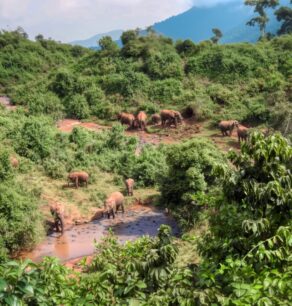
The Aberdare elephants are normally hard to spot due to the dense forest. However, on this day, we were lucky to spot a large herd near a watering hole. It was a picturesque view of the entire family, including young elephants.
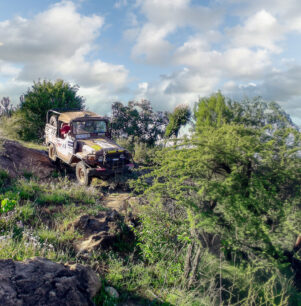
The Rhino Charge is an annual off-road competition held in Kenya to raise funds for the Rhino Ark Charitable Trust. Rhino Ark is a dedicated charitable organization working to protect Kenya’s vital water towers, such as Mount Kenya, the Aberdares, and the Mau Escarpment. Teams volunteer to navigate their 4×4 vehicles through challenging terrain in the Kenyan wilderness, raising millions of shillings to support this critical conservation effort.
Uh oh! It seems our trusty old Toyota Land Cruiser 40 series has encountered a bit of trouble!
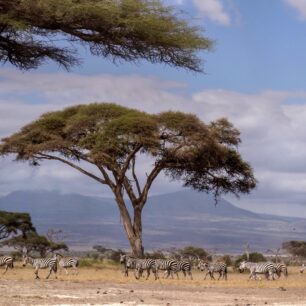
Amboseli National Park is renowned for its large elephant herds, drawn to the life-giving swamps fed by the majestic Mount Kilimanjaro. However, the park teems with a rich diversity of wildlife beyond elephants. Here, a vast herd of zebras gracefully traverses the savanna, passing by an ancient, imposing acacia tree.
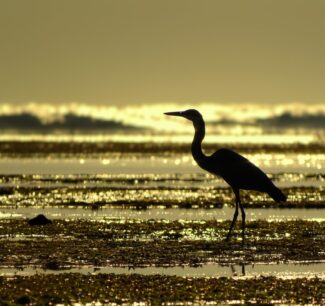
The sun bleeds over the horizon, painting the sky in warm hues of orange and gold. A Black-headed Heron, silhouetted against this calm backdrop, stalks the shallows. With slow, deliberate movements, it plucks small fish and crustaceans from the water, enjoying an early breakfast. Waves crash against the reef, generating the familiar calming sound of the sea, and the seaweed glistens in the sun.
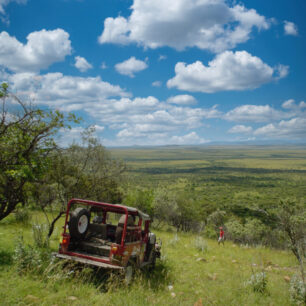
Imagine conquering Kenya’s rugged wilderness in a classic Toyota 40 Series Land Cruiser. That’s the challenge we face in the unmodified class of the Rhino Charge. Our 4.2-liter, carbureted six-cylinder engine and three-speed manual gearbox will be put to the ultimate test as we navigate 50 kilometers of treacherous terrain. Many vehicles succumb to catastrophic failures, but we’re determined to finish.
By participating in the Rhino Charge, you directly contribute to Rhino Ark’s vital mission of protecting Kenya’s water towers. These crucial ecosystems provide essential water resources for millions of Kenyans. Each year, the Rhino Charge raises millions of shillings to fence and safeguard these areas, ensuring a sustainable future for both people and wildlife.
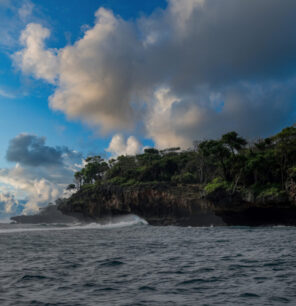
Wasini Island, located off the southern coast of Kenya near the small port town of Shimoni, is the first landmark you encounter as you venture into the Indian Ocean. This picturesque island boasts dramatic cliffs, lush vegetation, and towering baobab trees, all framed by the azure waters of the Indian Ocean. Despite its beauty, Wasini has a small population due to the lack of fresh water, which has limited development. As you leave Shimoni harbor, the island’s striking silhouette and the sight of waves crashing against its elevated coral walls create an unforgettable impression.
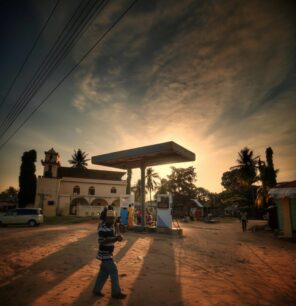
This unassuming petrol station in Msambweni, Kwale County, was a welcome sight as I topped off my tank for the final leg of my journey home to Munje. The sun dipped below the horizon, casting a warm glow that painted the scene with vibrant hues. As I turned my car, I was greeted by a picture-perfect vista framed by my window. I grabbed my camera, capturing this evocative image of a quintessential Kenyan petrol station bathed in the golden light of dusk.
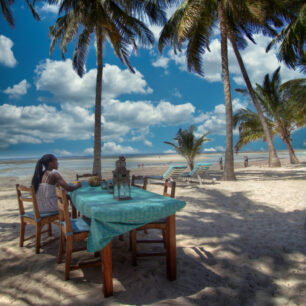
There’s nothing quite like a cool afternoon on the Kenyan coast. As the sun starts descending, a refreshing breeze sweeps in from the turquoise waters of the Indian Ocean, carrying with it the scent of salt and seaweed. Combined with the breathtaking views of pristine beaches and swaying palm trees, it makes for an idyllic escape.
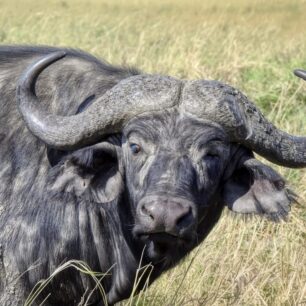
“He stood alone, a monument to survival. This old buffalo, his coat bleached by the sun and scarred by countless battles, watched us with a half blind weary, blue eye. His horns, worn and chipped like old piece of wood, spoke of a life lived in the wild. There was a sadness in his gaze, the loneliness of an aging warrior cast out from the herd.”
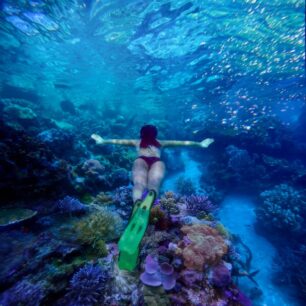
The Kisite Mpunguti Marine Park is a stunning marine reserve located southeast of the bustling harbor city of Shimoni. A typical day trip involves sailing out to the vibrant coral reef, exploring its depths through diving or snorkeling, enjoying a leisurely lunch, and then sailing back to Shimoni. Keep an eye out for playful dolphins, as encounters with these magnificent creatures are quite common during the journey to and from Kisite reef.
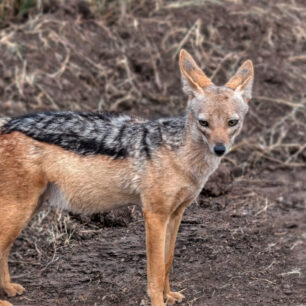
“This image captures a magnificent Black-backed jackal in its prime. With its distinctive black saddle and alert expression, it embodies the cunning and efficiency this species is known for. Black-backed jackals are renowned for their speed and incredible stamina, allowing them to chase down prey over long distances.”
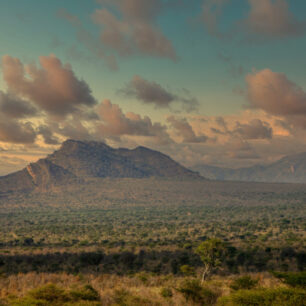
Tsavo West National Park in Kenya offers breathtaking views, capturing the essence of the African savanna. Small mountains rise across the landscape, creating a truly magical atmosphere. The image showcases a sweeping vista with dry savanna in the foreground, giving way to mid-sized hills and mountains shaped by ancient volcanic activity. Tsavo West is also renowned as the home of the maneless lions, made famous by the book “The Man-Eaters of Tsavo.”
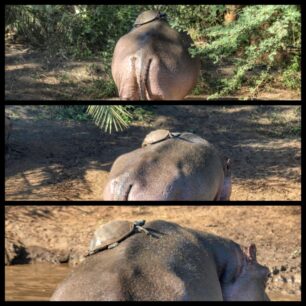
A turtle, blissfully basking in the afternoon sun on what it assumed was a stationary rock, suddenly found itself in motion. Unbeknownst to the reptile, it had chosen the back of a hippopotamus for its sunbathing spot. We had been observing a watering hole in Meru National Park when our presence disturbed the hippo, prompting it to leave the water and head towards the savanna. The turtle, now an unwitting passenger, was in for a bumpy ride as the hippo lumbered into the bush.
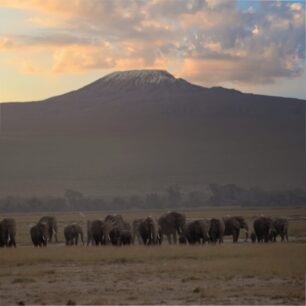
The pinnacle of our Amboseli safari arrived in a breathtaking late afternoon scene. A large herd of elephants, bathed in golden light, moved peacefully before the iconic silhouette of Mount Kilimanjaro. It was a moment of perfect alignment, where Amboselis splendor unfolded before our very eyes.
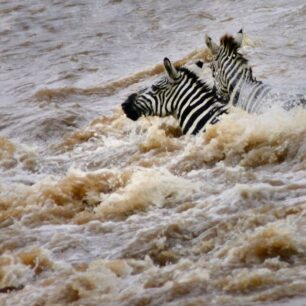
The zebras, caught in the middle of the river, are forced to swim with all their might, their heads barely above water. This crossing is a perilous undertaking, as the Mara River is known to harbor Nile crocodiles, masters of ambush who lie in wait for vulnerable prey. The zebras’ desperate fight for survival highlights the dangers faced by wildlife during the Great Migration, where the promise of greener pastures on the other side comes at a high cost.
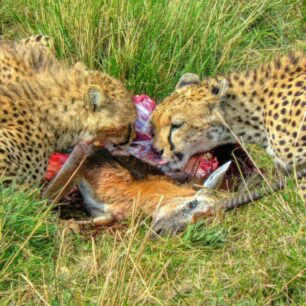
The cheetah, the fastest land animal, had just made a kill. We arrived in time to witness an incredible scene: a mother cheetah had brought down a Grant’s gazelle to feed her two cubs. The small family feasted, while the gazelle lay lifeless, its gaze fixed on the sky above. Though female cheetahs typically live and hunt alone, they raise their cubs independently, teaching them the skills they need to survive in the harsh African savanna. This magnificent predator, with its sleek, streamlined body built for speed, is truly a sight to behold.